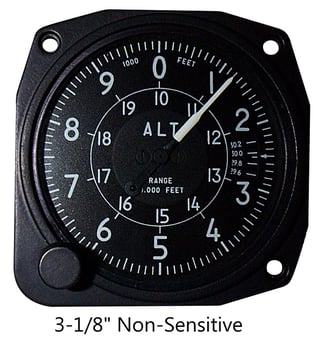In this answer reference was made to "sensitive" and "non-sensitive" altimeters.
What is the definition of each, what are the differences, and why would one be used in preference to the other?
And why isn't it called an "insensitive" altimeter?
In this answer reference was made to "sensitive" and "non-sensitive" altimeters.
What is the definition of each, what are the differences, and why would one be used in preference to the other?
And why isn't it called an "insensitive" altimeter?
All altimeters are "sensitive" to some extent (an "insensitive" altimeter would be one where the internal pressure-sensing mechanism has failed: the pointer wouldn't ever move).
What the FAA calls a "sensitive altimeter" is simply more sensitive than a regular (now often called non-sensitive) one:
Let's look at some (analog) examples:

This altimeter is similar to what you'd find on an old Piper Cub: The scale is marked in thousands of feet, with ticks every 200 feet.
This altimeter is not adjustable for "barometric pressure", but it is adjustable: The little knob on the bottom rotates the face of the altimeter. Put field elevation under the needle before you take off and it should be a reasonable approximation of your current altitude for the duration & distance of a typical Piper Cub flight.
These altimeters can only be "set" on the ground, because you need to know your elevation to set the position of the face or needle.

These show up from time to time: It's a non-sensitive altimeter (same scale markings we saw above), but it's adjustable for barometric pressure. The Kollsman window on this one is marked in inches of mercury.
When you turn the knob on this altimeter the needle moves and the barometric pressure that corresponds to "zero feet" shows up in the Kollsman window. This makes it easier to read than the previous example, and easier to reset in flight based on radio information: You can set the local barometric pressure (QNH) in the Kollsman window and get your current altitude without having to be on the ground at a known elevation.

In this sensitive altimeter you can see that there is a 100 foot scale (large pointer), and a 1000-foot scale (small pointer).
This is a bit of an unusual example: It's a sensitive altimeter that is NOT adjustable for barometric pressure (the knob simply adjusts the position of the pointers, and you set it to field elevation like you would with our first example. It can't be easily reset in flight as you need to know your current altitude to reset the altimeter correctly.

This the altimeter most pilots are used to seeing in a "steam gauge" panel: It is a sensitive altimeter (note the 100-foot scale pointer), and it is adjustable for barometric pressure (note the Kollsman window, marked in millibars in this example). This is the type of altimeter required for IFR flight.
This one happens to include 3 pointers (100-foot, 1,000-foot, and 10,000 foot), because it's calibrated to 20,000 feet.
As with most aviation products there is a Technical Standard Order (TSO) behind altimeters which would get into all the specific details of the differences.
For sensitive altimeters it's TSO C10 (I believe C10b is current).
I'm not sure if there's one for a non-sensitive altimeter.